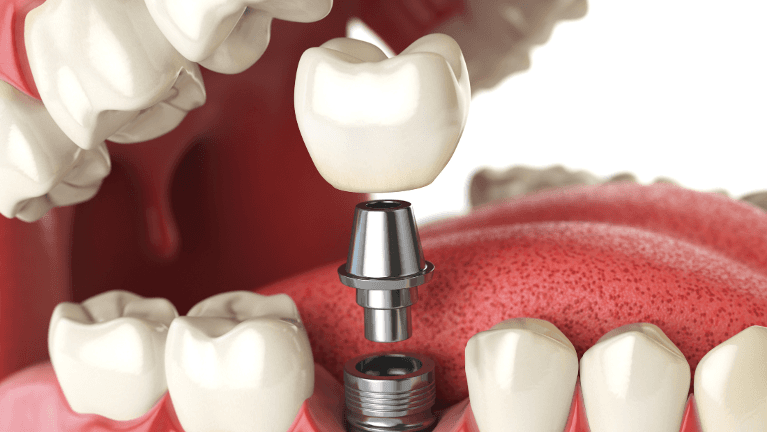
Dental implants are a feat of dental engineering. They offer a permanent option for dental restoration that replicates the look, feel, and function of natural teeth. Getting dental implants can be complex, so it’s essential to understand what it involves fully. This blog discusses each step of the implant process to help you decide if implants are the right choice for you.
What is a Dental Implant?
Dental implants are artificial tooth roots made of metal posts surgically placed into the jawbone to replace missing teeth. A screw-like post is implanted in the jawbone during surgery in place of the missing tooth.
Once the area has healed and the bone has accepted the post, it will act like the root of a natural tooth. An artificial tooth, or crown, is then attached to this post. Dental implants look and function like natural teeth, and their durability makes them an excellent alternative to dentures or dental bridges, which can have several drawbacks.
Why Are Dental Implants Used?
Dental implants are a durable, comfortable alternative to other dental prosthetic options. There are numerous benefits to choosing implants, which include:
- The metal posts do not deteriorate over time like natural teeth, so they can last a lifetime
- They are firmly positioned and do not move the way dentures can
- The posts integrate with your jawbone, which prevents bone loss
- They look and function exactly like natural teeth
The Dental Implant Procedure
Getting dental implants can be a long process, often taking several months. This period is primarily due to the healing periods required between the steps.
Initial Consultation and Evaluation
The first step is to schedule an appointment with your dentist. They will conduct a thorough examination, including x-rays, to determine bone health. This evaluation is vital; you must meet specific requirements for the dental implant procedure.
You will need sufficient bone density and structure to support the post, or you may need to undergo a bone graft procedure first. Before your surgery, you must avoid tobacco and maintain strict dental hygiene.
Treatment Planning
Your dentist will create a customized treatment plan based on your evaluation. This plan will outline the number of implants needed and the preparatory procedures required, such as bone grafts and tooth extractions. Your dentist will also discuss the timeline for your treatment, which will gradually proceed over multiple appointments.
One of the most essential parts of the planning phase is discussing cost estimates, insurance coverage, and your budget. Dental implants can be rather expensive due to the surgical element and the high-quality materials used.
Dental Implant Preparation
Some patients require additional procedures before the implant surgery can take place. If your jawbone does not have adequate density to hold the dental post, you may need a bone graft to create a foundation for the implant.
Damaged teeth must be removed before the dental implant procedure. These additional preparation steps can add several months to the timeline as you must fully heal before your dentist can proceed with the next step.
Implant Placement Surgery
Once your dentist confirms you are ready to proceed, you will schedule your implantation surgery. The surgery is typically done under local anesthesia, meaning you will be awake. If you prefer to be asleep, you must pay an additional fee. Here’s what to expect for the surgery:
- Your dentist will make small incisions to expose the jawbone.
- A small hole is carefully drilled into the bone.
- The metal post is inserted into the prepared bone.
- The dentist uses stitches to close the implant.
You can expect the surgery to take 1-2 hours per implant and should only experience minimal pain and discomfort. Discussing your pain management needs before the surgery is vital to ensure your comfort throughout.
After the surgery, the healing period, known as osseointegration, begins. During this time, the implant will fuse with the surrounding bone to create a stable base for your new tooth. Complete osseointegration can take up to six months. It is crucial to carefully follow your dentist’s diet and oral hygiene instructions to minimize the risk of infection or rejection.
Abutment and Crown Placement
Once osseointegration is complete, your dentist will perform a second minor surgery, reopening the gum slightly to place the abutment. This apparatus is the connector between the implant and the crown, which will be attached next. Over the next two weeks, you will continue your strict dental hygiene routine to ensure your incisions heal properly.
The last step is the placement of the final prosthetic tooth. This crown is custom-made to match the exact color, size, and shape of your natural teeth, which makes it virtually undetectable. Your dentist will provide guidelines to help you care for your implants properly to ensure they last forever. Crowns typically require replacement every 10-15 years, but you can expect to enjoy the stability of your implants for the rest of your life.
Your Path to a Renewed Smile
While lengthy, the dental implant process offers a permanent, natural-looking solution for missing teeth. You can confidently approach your procedure with a clear understanding of what to expect at each stage. Contact Dr. Nargiz Zadeh to schedule your consultation so we can discuss your options. Every patient’s journey is unique, so we will carefully tailor your treatment plan to meet your specific needs.
If you’re considering dental implants, Dr. Nargiz Zadeh is ready to help you reclaim the healthy, beautiful smile you deserve.